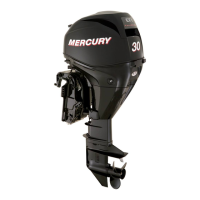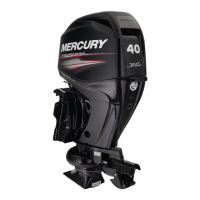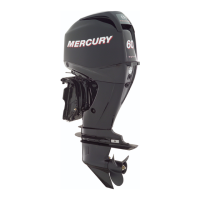General Information
90-8M0065421 NOVEMBER 2012 Page 1C-7
Weight Distribution (Passengers and Gear) Inside the Boat
Shifting weight to rear (stern):
• Generally increases speed and engine RPM
• Causes bow to bounce in choppy water
• Increases danger of following wave splashing into the boat when coming off plane
• At extremes, can cause the boat to porpoise
Shifting weight to front (bow):
• Improves ease of planing
• Improves rough water ride
• At extremes, can cause the boat to veer back and forth (bow steer)
Bottom of Boat
For maximum speed, a boat bottom should be nearly a flat plane where it contacts the water and particularly straight and
smooth in fore and aft direction.
•
Hook: Exists when bottom is concave in fore and aft direction when viewed from the side. When boat is planing, hook
causes more lift on bottom near transom and allows bow to drop, thus greatly increasing wetted surface and reducing boat
speed. Hook frequently is caused by supporting boat too far ahead of transom while hauling on a trailer or during storage.
•
Rocker: The reverse of hook and much less common. Rocker exists if bottom is convex in fore and aft direction when
viewed from the side, and boat has strong tendency to porpoise.
•
Surface roughness: Moss, barnacles, etc., on boat or corrosion of outboard's gear housing increase skin friction and
cause speed loss. Clean surfaces when necessary.
Water Absorption
It is imperative that all through‑the‑hull fasteners be coated with a quality marine sealer at time of installation. Water intrusion
into the transom core and/or inner hull will result in additional boat weight (reduced boat performance), hull decay, and eventual
structural failure.
Cavitation
Cavitation occurs when water flow cannot follow the contour of a fast‑moving underwater object, such as a gear housing or a
propeller. Cavitation increases propeller speed while reducing boat speed. Cavitation can seriously erode the surface of the
gear housing or the propeller. Common causes of cavitation are:
• Weeds or other debris snagged on the propeller
• Bent propeller blade
• Raised burrs or sharp edges on the propeller
Elevation and Climate
Elevation and climate changes will affect the performance of your power package. Loss of performance can be caused by:
• Higher elevations
• Higher temperatures
• Low barometric pressures
• High humidity
For you to have optimum engine performance under changing weather conditions, it is essential that the engine be propped to
allow the engine to operate at or near the top end of the specified maximum RPM range with a normal boat load during your
normal boating weather conditions.
In most cases, recommended RPM can be achieved by changing to a lower pitch propeller.
Detonation
Detonation in a 4‑cycle engine resembles the pinging heard in an automobile engine. It can be otherwise described as a tin‑like
rattling or plinking sound.
Detonation is the explosion of the unburned fuel/air charge after the spark plug has fired. Detonation creates severe shock
waves in the engine. These shock waves often find or create a weakness: the dome of a piston, cylinder head or gasket, piston
rings or piston ring lands, piston pin, and roller bearings.
A few of the most common causes of detonation in a marine 4‑cycle application are as follows:
• Over‑advanced ignition timing
• Use of low octane gasoline

